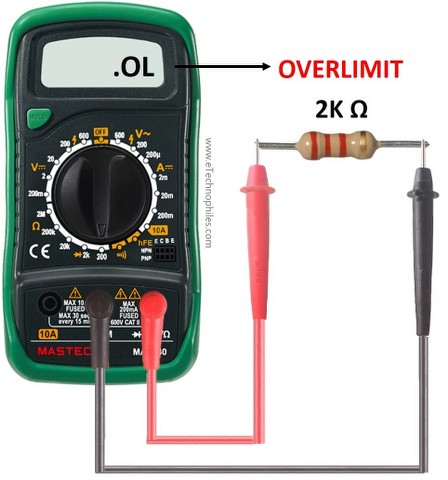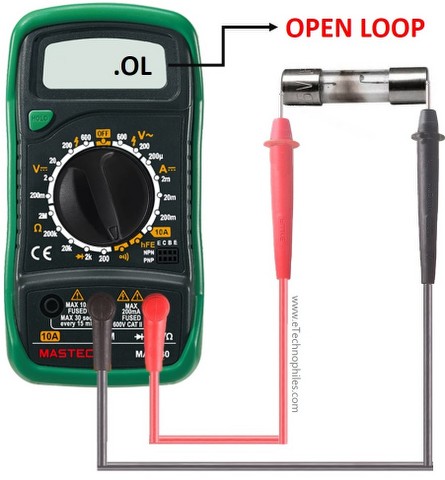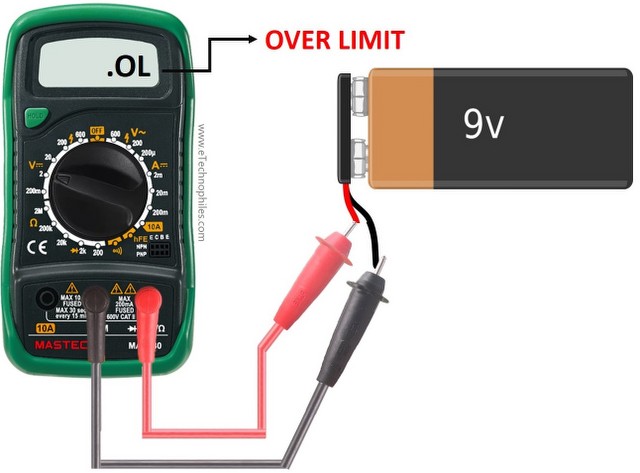Last updated on October 13th, 2023 at 05:57 pm
With a modern digital readout multimeter, you can test voltage, current, and resistance with the same tool. Electricians use multimeters every day, and they can also be helpful to homeowners who are starting a DIY electrical project or just trying to troubleshoot an electric an electrical issue before calling a professional.
Although some pros still swear by analog multimeters, there were glaring limits with these devices before digital was an option. Their digital counterparts boast all of the following advantages over analog:
- Easier to read
- More accurate
- Instant troubleshooting
To maximize the functionality of your digital multimeter, there are several codes you’ll need to know, including the OL readout.
What does OL mean on a multimeter readout?
Every multimeter is different, but in most cases, OL stands for “Overload” or “Over Limit.” You’ll see the OL error when testing for voltage (volts) or resistance (ohms) if your multimeter range is set too low — or when the voltage or resistance is much too high. In the continuity mode, OL means “Open loop”.
This doesn’t necessarily mean the voltage or resistance is excessive. It just means the multimeter isn’t set high enough to detect the electrical property you are measuring. There’s a quick fix for this, which we’ll go over in a moment.

Table of Contents
Can OL mean anything else on your multimeter?
But first, let’s look at the other situation that might result in an OL error.
In some cases, OL can mean “Open Loop.” An open loop is more commonly called an open circuit. Sometimes, a circuit is left open intentionally, like a light switch or flashlight. When the circuit is completed, the light comes on.

An Open Loop means the signal isn’t making it back to the multimeter for one reason or another, resulting in an interrupted flow. When you test for continuity with a multimeter, you can tell if there is a disruption in the circuit that should not be there.
An Open Loop is caused by a few things:
- A broken wire somewhere in the circuit
- Disconnected battery
- Dirty probes on your multimeter
If you’re getting an OL signal due to an Open Loop — but you really don’t think you should be — check these things first.
How do you know if OL refers to Overload or Open Loop?
Some multimeters have different codes for these two scenarios, but most do not. Therefore, you must know how to tell which issue OL is alerting you to. Confusion about the OL reading wasn’t a problem with older or simpler voltmeters, which only measure (you guessed it) voltage.
Fortunately, it’s easy to tell with modern multimeters as long as you are familiar with the one you’re using. Depending on which setting you have it on — what you’re testing for — OL can only mean one or the other.
For example, if you have it set to test for voltage, it means Overload for volts. You should either set the range on your multimeter higher or use a different multimeter with a higher range. Similarly, if measuring for resistance, OL will tell you that the ohms are over the limit capable of being read by your multimeter.

Again, these readings don’t necessarily mean that you are dealing with excessive or dangerous levels, simply that your multimeter isn’t designed to measure the levels that you are testing.
However, you should always be careful when working with electricity. Just because levels are within range doesn’t mean they are harmless.
On the other hand, when OL stands for Open Loop, it’s because you have it set to test for continuity. So when you see OL on the display, all you have to do is verify which electrical feature you are testing for, and you’ll know whether it means Over Limit (Overload) or Open Loop.
How to avoid getting an OL error on a multimeter?
If you are consistently seeing OL on the digital display of your multimeter, you can adjust the approximate high range that you expect. For example, if you expect that the voltage will be 120V, you’ll need to set your range at the next highest setting, like 200V, to ensure that you don’t get the Over Limit reading.
Another case where you can avoid getting an Over Limit (Overload) error is when there actually is an issue with the voltage. If an outlet is supposed to be 110V but it’s actually 220V, there is definitely a problem. If you expect it to be 110V, you’d probably set that max range to 200V or less.
Getting an OL reading in this case is an indication that there is a voltage issue that needs to be resolved.
There’s no way to avoid getting an Open Loop reading if there is, in fact, an open circuit. However, you could be forgetting to do something simple, like flipping the light switch, in order to close the loop. Make sure everything is connected properly and that all switches are ON before testing continuity to avoid getting an OL reading for continuity.
